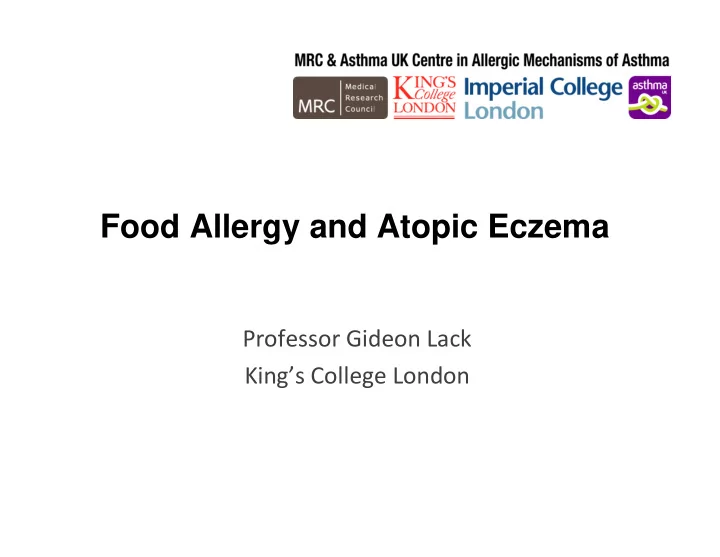

Food Allergy and Atopic Eczema Professor Gideon Lack King’s College London
Relationship between Food Allergy & Atopic Dermatitis � Food allergy Atopic dermatitis � Atopic dermatitis Food allergy � Atopic dermatitis Food allergy
Prevalence of AD in FA 100 91.3 88.1 90 80 70 % with eczema 60 50 42 40 30 20 10 0 Peanut Allergic Egg Allergic Unselected p<0.001 p<0.001
Prevalence of food allergy* and atopic dermatitis 56% � Sampson 1985 73% � Sampson 1995 37% � Eigenmann (Baltimore) 1998 27% � Eigenmann (Geneva) 2000 81% � Niggemann 1999 55% � Roehr 2001 * Proven by DBPCFC
The relationship between eczema severity and the frequency of high-risk IgE food sensitization (HR-IgE-FS) to foods according to the age of onset of eczema is shown. The children with the most severe eczema (Q4), and the earliest age of onset (3 months), had the greatest frequency of HR-IgE-FS D. J. Hill, C. S. Hosking, F. M. de Benedictis, A. P. Oranje, T. L. Diepgen, V. Bauchau and the EPAAC Study Group. Clin Exp Allergy. 2008 Jan;38(1):161-8.
Does food allergy cause atopic dermatitis? � Oral Provocation Studies � Interventional Studies
Oral Provocation Studies � 139 children, mean age 13 months � Mild AD 59%, Moderate 32%, Severe 9% � Suspected food involvement by doctor or parent Niggemann B. J Allergy Clin Immunol 2001; 108: 1053-1058
DBPCFC to milk, egg, wheat and soy in children median age 2 years with AD and suspected FA 106 challenges in 64 patients 57 Positive challenges 49 Negative challenges 43.5% Immediate 56.5% Delayed reactions eczematous only Lesions* 45% Delayed 12% Delayed eczematous eczematous Delayed = >24hrs lesions after lesions only immediate symptoms *Mean increase in SCORAD 14.2, p<0.001 Breuer K. Clin Exp Allergy 2004; 34: 817-24.
Causes of late eczematous reactions Other Milk 15% 28% Wheat 21% Soya Egg 9% 27% Breuer K. Clin Exp Allergy 2004; 34: 817-24.
Does food allergy cause atopic dermatitis? � Oral Provocation Studies � Interventional Studies
Interventional studies: Can Dietary Restriction Improve Atopic Dermatitis? � 16 interventional studies to address this � No meta-analyses � Varying � Study populations � Intervention � Design � Outcome measures Fiocchi et al. Allergy 2004; 78: s78-85.
Review of Studies � 15 of 16 studies report some response, but variable � Interventions most effective in infants � Successful interventions include egg, milk & wheat avoidance � Effect is generally small Fiocchi et al. Allergy 2004; 78: s78-85.
Relationship between Food Allergy & Atopic Dermatitis � Food allergy Atopic dermatitis � Atopic dermatitis Food allergy � Atopic dermatitis Food allergy
Cutaneous Route IgE “Allergy” Saloga et al. Am J Respir Crit Care Med 1994; 149: 65-70 Strid et al. Eur J Immunol 2004; 34: 2100-9
Route of peanut exposure Cutaneous exposure PEANUT α 4 β 7+ T cells TOLERANT (NA) PEANUT CLA + T cells ALLERGY Oral (PA) exposure Chan et al. Allergy. In Press.
100% 100% P ercen tag e o f to tal p ro liferatio n (% ) P ercentage of total proliferation(% ) 80% 80% 60% 60% CLA% CLA% B7% B7% 40% 40% 20% 20% 0% 0% 1 2 3 4 5 6 7 8 9 10 1 2 3 4 5 6 7 8 9 10 Peanut Allergic Peanut Non Allergic CLA+ and α 4 β 7+ proliferation as a percentage of total CLA+ and α 4 β 7+ proliferation to 400 � g/ml peanut in each patient on day 5, showing proliferation to peanut predominating in the CLA subset of PA patients and a more mixed response in peanut tolerant (NA) patients. Chan et al. Allergy. In Press.
Peanut allergy is associated with: � Eczema: OR = 2.6, 95% CI 1.4 - 5.0 � Oozing crusted rash: OR = 5.2 , 95% CI 2.7 - 10.2 � Topical Arachis oil: OR = 6.8 , 95% CI 1.4-32.9 Lack G et al. NEJM 2003; 348: 977-985
Proportion of allergic children with peanut allergy as a function of household peanut consumption during infancy, and as a function of maternal peanut consumption during pregnancy 1 .8 Proportion peanut-allergic .6 .4 n=286 .2 n=97 0 0 50 100 150 Average total household peanut consumption during 1st yea Fox AT et al. J Allergy Clin Immunol 2009; 123: 417-23.
Bed-sheet Pillow-case (mcg/m 2 ) (mcg/m 2 ) p=0.01 p=0.06 7 8 2.3
Household peanut consumption and infant environmental peanut exposure
Filaggrin • Filaggrin forms a dense protein lipid matrix regulating permeability of the skin to water and external particles • Loss-of-function filaggrin mutations: – Common (up to 10%) in Caucasian populations – Associated with up to 50% of moderate-severe eczema – Associated with peanut allergic (OR 5.3; CI 2.8-10.2) I UK and Canada even after controlling for coexistent eczema (p=0.0008) Sandilands A et al. Nature Genetics 2007;(5):650-4. Brown SJ et al. JACI 2011; 127(3-4): 661–667
Normal Patient Filaggrin Deficient Patient Adapted from Irvine AD et al. N Engl J Med 2011;365:1315-27
Adapted from Irvine AD et al. N Engl J Med 2011;365:1315-27
Summary � Food allergy Atopic dermatitis � Atopic dermatitis Food allergy � Atopic dermatitis Food allergy
Recommend
More recommend